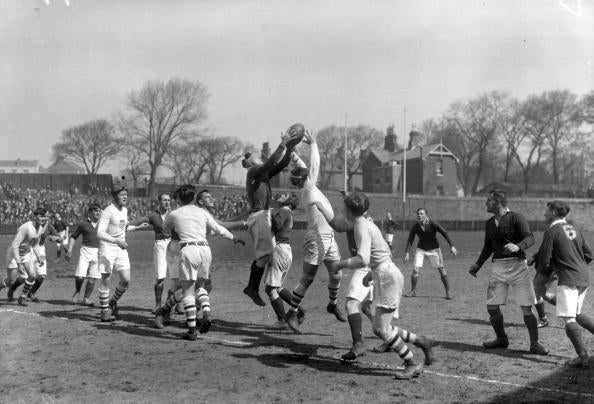The Last Word: Why rugby and golf belong in the Olympics
Incredible tales of sportsmanship from days gone by prove that pastimes deserve slot in five-ringed circus

It seems that rugby union is to be reintroduced into the Olympic arena in a scaled-down form. Last contested in all its 15-man glory in 1924, the oval-ball game is in line for a return in 2016, but in its seven-a-side format.
Perhaps golf, which has also been recommended by the International Olympic Committee's executive board ahead of a vote by the full IOC membership in Copenhagen in October, should have pitched itself on the short side too. Olympic pitch and putt, anyone? Olympic crazy golf? Those windmills might have sorted out the real Tigers from the cubs.
Still, there is always the prospect of John Daly presenting him-self as a new-age Olympic role model, sporting a pair of his Smarties-design trousers and with a fag smouldering between his lips as he tees off on a practice round. The technically reigning – though actually long-deceased – Olympic champion of the fairway was something of a colourful character himself.
George Lyon was 46 when he travelled with the Canadian team to the 1904 Games in St Louis, youthful only by the Tom Watson scale. He had not picked up his first golf club until he was 38 and had a style so rugged it was suggested he looked like he was heaving coal rather than swinging an iron. In fact, he had been more accustomed to swinging a bat, as a cricketer of some renown in the land of the Maple Leaf. He was also the Canadian record holder in the pole vault.
No-one expected the man from Richmond, Ontario, to get through a 72-strong field as far as the match-play competition for the gold medal. And no-one gave the fortysomething an earthly of beating his opponent, Chandler Egan, a 23-year-old US amateur champion. The youth and vigour of the American were supposed to win the day.
In the end, Egan could only marvel as his opponent sang and cracked jokes in the rain and sent drives booming into the distance. He was nonplussed when Lyon walked on his hands to receive the $1,500 sterling silver winner's trophy and his Olympic gold medal. The clowning Canadian could have collected another gold four years later, but he declined out of respect for the game.
Lyon made the trip to London for the 1908 Games, only to find himself as the sole entrant. By slotting the tournament into the first week in June, the British Olympic Association stirred up opposition from the Royal & Ancient Golf Club for clashing with established domestic events. All of the British golfers withdrew from the competition and no Americans were prepared to make the trip. Lyon was offered the gold medal by default but he declined to accept it. He died in 1938, aged 79, but now the sport in which he made his most profound mark is poised for an Olympic resurrection. It will be all the more welcome in the quadrennial five- ringed circus if it can bring class acts like George Seymour Lyon to the greatest sporting show on earth. Ditto rugby sevens.
The oval-ball game first appeared in the Olympic arena, in its 15-a-side guise, in those London Games of 1908. The original Wallabies, the first touring Australian national side, became champions almost by default. The world's leading nations having declined to enter the competition, they found themselves playing Cornwall – representing Britain because they had won the English county championship – for the Olympic title.
On a makeshift pitch next to the open-air Olympic swimming pool at Shepherd's Bush, the Australians won 32-3 – under the captaincy of Herbert Moran, who gained considerable fame in later life as an eminent physician and author. It was Moran who objected to the aboriginal war dance the original Wallabies were forced to perform by the Australian rugby authorities, who wanted a rival ritual to the haka popularised by the All Black "Originals" in 1905. The good Dr Moran considered the treatment of Australia's indigenous population such a disgrace that he successfully fought for the abolition from future Wallaby tours of what he called "a wretched caricature of a native corroboree".
He had one other notable success on that historic 1908 trip. Concerned that his players would catch venereal disease during the first few weeks on board the SS Omrah, Moran made them attend daily lectures about the ailment, showing them graphic pictures of gravely afflicted private parts. He warned that any player who contracted the disease would be sent home in disgrace. None were. "I count this as a real achievement for both them and for me," he observed in his autobiography, Viewless Winds.
Dan Carroll was one of those who returned home with a gold medal and a clean bill of health. The flying winger also won a gold as player-coach with the victorious American team in Antwerp in 1920, then guided the US to victory in the 1924 final in Paris. The United States have reigned as Olympic rugby champions ever since – because of the riot provoked by their 17-3 success against the French at Stade Colombes.
An ill-tempered affair ended with the US team being booed, hissed and spat upon by Parisians. Two Americans sitting in the main stand were beaten unconscious as Carroll and his players were escorted from the field under police protection. The playing of "The Star Spangled Banner" was drowned out by jeers at the victory ceremony. The playing of rugby at the Olympics duly sank thereafter, though not without trace, it would seem.
Subscribe to Independent Premium to bookmark this article
Want to bookmark your favourite articles and stories to read or reference later? Start your Independent Premium subscription today.

Join our commenting forum
Join thought-provoking conversations, follow other Independent readers and see their replies